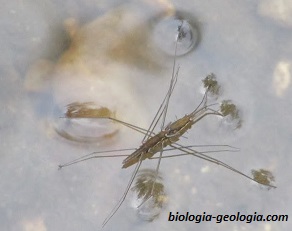Water properties
Although you probably haven't started studying chemistry yet, you probably know that the formula for water is H2O. Water is made up of molecules made up of two hydrogen atoms (H) bonded to one oxygen atom (O). Although the electrical charge of each water molecule is neutral, it presents a dipolar structure, in such a way that it presents a somewhat negative charge in the zone of the oxygen atom, and a positive charge where the hydrogens are.
There is an attraction between these positive charges and other negative charges of other molecules and bonds called "hydrogen bonds" are produced. These bonds make the water in a liquid state at room temperature and not in a gaseous state as would be expected.
Water is colorless, odorless, tasteless, incompressible, and in addition to these characteristics, we are going to deal with some of the properties of water due to its chemical structure:
- thermoregulatory function.
- Higher density in the liquid state than in the solid state.
- Great solvent power.
- Conductor of electricity.
- High strength of cohesion and adhesion.
Politicians and science: Cristina Fernández de Kirchner, former president of Argentina, almost knows the formula for water .
Video: Properties of water (Amoeba sisters)
Water has thermoregulatory function
Water has a high specific heat. That is, it takes a lot of heat to increase its temperature, compared to other substances. It is capable of absorbing a lot of heat without hardly increasing its temperature. This is because the energy is used to break hydrogen bonds, not to increase the temperature by molecular agitation. Thus, it heats up and cools down more slowly than other liquids.
This property makes it have a thermoregulatory function, being a thermal stabilizer, keeping the body's temperature relatively constant, despite environmental fluctuations. For example, when we regulate our temperature with sweat.
In the same way, it also attenuates temperature variations, and the temperature of coastal areas are milder than those of inland areas. Its effect can also be seen in the sea breezes that, during the day, the air that is on the continent warms up more, rises, and is occupied by the cooler air mass that is over the sea.
Water has a higher density in the liquid state than in the solid state
Normally, when we heat an object, it expands, and when we cool it, it contracts. But with water this does not happen. When the temperature drops, it freezes and expands.
The temperature at which water has the greatest density is 4°C. If the temperature drops, the water molecules are ordered and their volume increases, so their density decreases. This makes the ice (solid state) float on top of liquid water because it is less dense and there may be life below in aquatic ecosystems. The ice acts as a thermal insulator and prevents life from existing in the polar areas under water.
Water has great solvent power
Water, in addition to being very abundant on Earth, is the universal solvent, the one that can dissolve more substances. The polarity of its water molecules allows it to react with ions and electrically charged molecules, as well as other polar substances.
In nature we will not find pure water, H2O, but it is with a certain amount of salts in solution. Sea water still has a higher concentration of salts, with chlorine ions, sodium, calcium, magnesium, etc. Although not visible to the naked eye, salt becomes visible when the water in the salt pans evaporates.
The great solvent capacity of water allows it to perform two important functions:
- Transport function: Water is the main means of transport for organisms (blood, raw and processed sap).
- Metabolic and biochemical function: In the water, the biochemical reactions typical of life take place (which are carried out between molecules dissolved in water).
Water is a conductor of electricity
Although pure water is not a good conductor of electricity because it is neutral, in nature, water contains dissolved ions that make it a conductor of electricity. This allows electrical potentials to be created inside and outside the cells, necessary for muscle contraction, for example.
Although electricity can be very dangerous for living beings, it can also be used to revive the heart in case of cardiac arrest.
